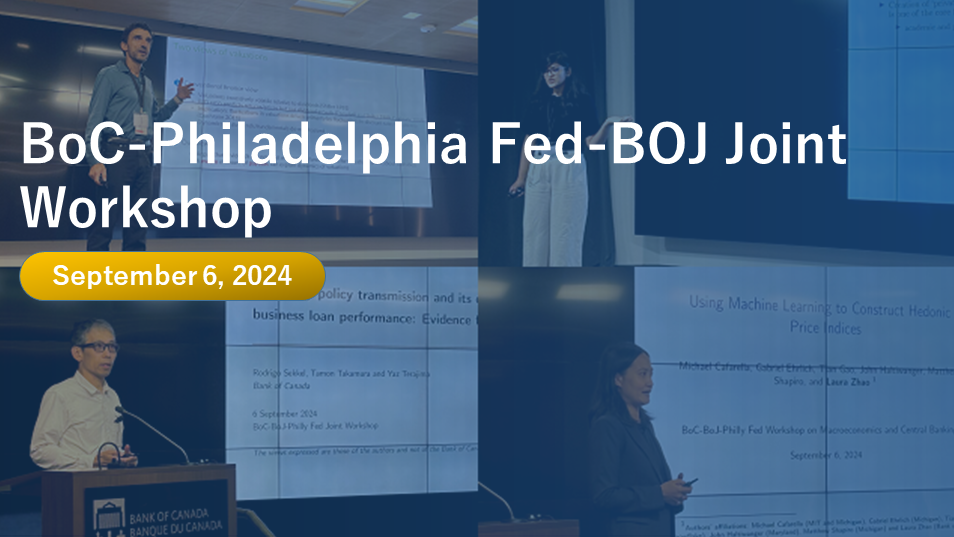The joint workshop, organized by the Bank of Canada (BoC), the Bank of Japan (BOJ), and the Federal Reserve Bank of Philadelphia, was held at the Bank of Canada in Ottawa on September 6, 2024, with the theme "Macroeconomics and Central Banking".
The workshop was initiated by the BoC and the BOJ in 2013, with the Federal Reserve Bank of Philadelphia joining in 2019, to promote research discussions and share latest policy-relevant research among participating central banks and academic researchers. This year, in the seventh workshop, two external speakers were invited: Dr. Fabrizio Perri (Federal Reserve Bank of Minneapolis), and Professor Isha Agarwal (University of British Columbia).
From among the papers presented at the workshop, this newsletter summarizes two papers that tackle fundamental issues in macroeconomics and finance, and another two papers that conduct empirical analyses using "big data".[1]。
1. Market valuations and real economic activity
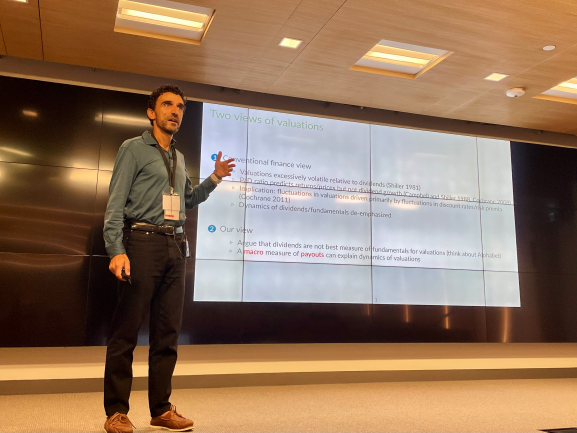
It is a well-known fact that the market valuations of public corporations are volatile, while most macroeconomic variables such as GDP growth and capital-output ratio are stable. Reconciling this "disconnect" has been a puzzle, and a similar observation is the "excess volatility puzzle" (Shiller, 1981), where stock prices move too much to be justified by subsequent movements in dividends.[2]
Dr. Perri tackled this fundamental issue in macroeconomics and finance, arguing that fluctuations in expected cash flows to firm owners had been the dominant driver of fluctuations in the market value of U.S. public corporations.[3] He first introduced a unified dataset known as the integrated macroeconomic accounts (IMA) and defined the cash flow measure as gross value added less compensation of employees less investment expenditures.[4] He then explained that there was ample volatility in the cash flows in the IMA data to resolve the "excess volatility puzzle," and showed that relatively modest shocks to expected future cash flows could account for the history of corporate valuations from 1929 to 2023, without appealing to fluctuations in discount rates.
As emphasized by Dr. Perri, the rich information in the IMA data has huge potential for advancing research in macroeconomics and finance. For example, market valuations of corporations are related to economic growth, according to the literature on endogenous growth, and those of banks are related to financial stability, according to the literature on banking. Uncovering facts using data such as the IMA and developing a unified model of macroeconomics and finance would be a fruitful research agenda. Understanding the drivers of stock market fluctuations in the U.S. and in other countries has also important implications for international risk sharing.[5]
2. Private money creation and bank assets
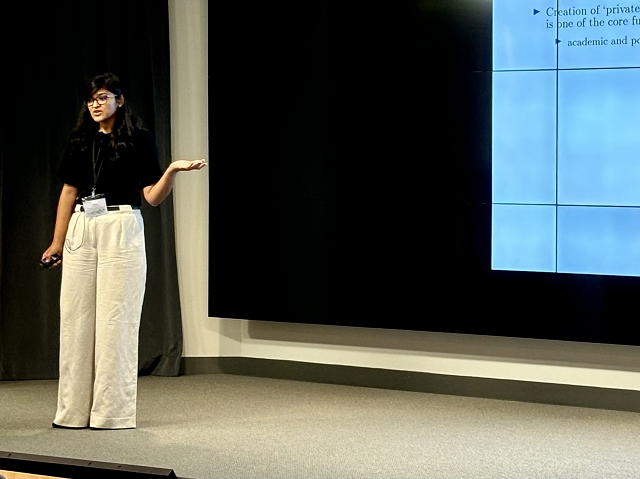
Banks produce money-like securities – deposits – that are accepted at par without question when transacting, while such money is backed by risky assets i.e., lending. How can this be possible? Dang, et al. (2017) argue theoretically that banks can do so by keeping information about their assets secret and making themselves opaque.[6] According to the theory, bank assets that are opaque, i.e., those that are thought to be safe and are difficult to evaluate, disincentivize market participants and depositors from evaluating bank assets, making no one cast doubt on the quality of these assets. In this way, opacity in bank assets supports and facilitates banks' money creation.
Professor Agarwal empirically investigated this information view of banking.[7] Specifically, she put forward the hypothesis that banks lend at lower interest rates to firms that are opaquer, because banks have an incentive to lend to such firms, as explained above. She added that to isolate the effect of opacity on an interest rate discount, the paper tested whether bank loan interest rates are relatively lower than corporate bond interest rates for opaquer firms. She then reported that the hypothesis was supported by empirical analyses that employ the data on loan-bond pairs of non-financial listed firms in the U.S. Based on this result, she argued that banks' money creation required opaque assets and thus affected asset portfolios.
According to this information view of banking, if bank assets are thought to have lost enough value to raise doubts among market participants and households, bank assets become information sensitive, and so do deposits, giving rise to a bank run. The March 2023 banking sector turmoil in the U.S. appears to be consistent with this view. With developments in information technologies and how information is shared and spread, through social media for example, more research is needed to deepen our understanding of the nature of banking and banking crises.
3. Monetary policy transmission and its effects on small business loan
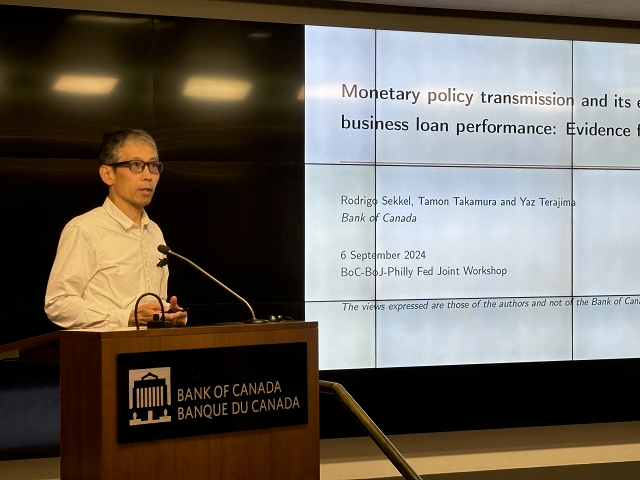
Small enterprises are important players in the economy, contributing to employment and output. However, many of these firms are bank-dependent and susceptible to interest rate changes. The impact of monetary policy on the performance of existing small business loans has been under-explored, and its analysis can potentially deliver useful policy implications for the current economic situation in which interest rates are changing significantly.
Dr. Tamon Takamura (BoC) explored this issue by utilizing confidential, anonymized loan-level data from the Business Development Bank of Canada, a federal Crown corporation, which has a large presence in the Canadian small-business loan market.[8] This study analyzed two channels of monetary-policy transmission: the aggregate demand channel and the cash-flow channel, which pertain to firms' revenue and debt repayment, respectively. He showed that a 6-basis point surprise increase in the short-term interest rate would raise the probability of loans being in arrears, impaired or written-off by 21 basis points, on average, in the 15-month. He added that the cash-flow channel takes effect by increasing the burden of debt repayment when the tightening effect of the aggregate demand channel reaches its peak.
This study provides novel insights into the effects of monetary policy on existing small business loans through different channels over time. This research also examined the disciplinary effect of collateral on loan repayment and found a result that collateral reduces the moral hazard in loans used for investment but not in other loans in Canada.
4. Machine learning and price indices
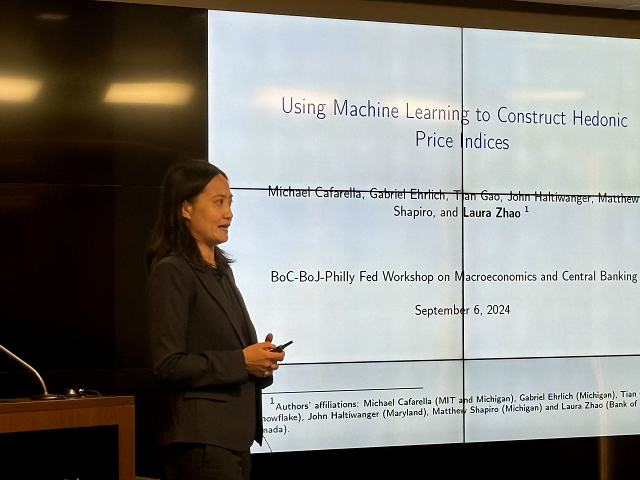
Measurement is the origin of science. The need for measurement after the floods of the Nile River in ancient times is said to have contributed to the development of mathematics and science. In economics, as a branch of social science, the importance of accurate measurement is widely recognized. For example, in measuring inflation rates, the challenge lies in accurately assessing inflation amidst rapid product turnover and swiftly changing consumption patterns.
Dr. Laura Zhao (BoC) tried to address this issue using item-level transaction data from U.S. retail sales.[9] First, she explained that when new products replace old ones, characteristics such as functionality could change, and thus it was necessary to account for these changes to accurately measure inflation. She continued that the hedonic method had traditionally been employed by regressing prices on item characteristics to estimate each characteristic's contribution to the price; but the challenge was how to select meaningful characteristics and to take into account non-linearity. She then argued that a machine learning algorithm using neural networks would be useful by enabling large-scale implementation of the hedonic method. She applied this technique to Nielsen Retail Scanner data, which includes over two million products, and reported that the inflation rate of foods from Q4 2006 to Q4 2015 was reduced from 5.9% to 2.8%.
Combining big data and machine learning has huge potential for statisticians and central bankers. As the digitalization of the economy advances, more data become available, increasing the comparative advantage of machine learning over traditional methods. The methodology developed in this paper could be applied beyond food to other goods and services. For instance, durable goods would be a prominent candidate for this application, as new features are frequently incorporated into updated products. Moreover, the methodology can be applied to the adjustment of quality in services, where characteristics are often described in text and difficult to quantify. Machine learning, particularly in its ability to handle non-numerical data efficiently, offers significant advantages in these cases.
Notes
- In addition to the papers summarized here, from the Federal Reserve Bank of Philadelphia, Dr. Shigeru Fujita presented a paper titled "Government Transfers and Labor Shortages During the COVID 19 Pandemic," and Dr. Igor Livshits presented a paper titled "Building Credit Histories." From the BOJ, Dr. Daisuke Ikeda presented a paper titled "Why Aging Induces Deflation and Secular Stagnation," and Dr. Koji Takahashi presented a paper titled "To Lend or Not to Lend: The Bank of Japan's ETF Purchase Program and Securities Lending." [1]
- Shiller, R. J. (1981) "Do stock prices move too much to be justified by subsequent movements in dividends?" American Economic Review 71(3): 421—436. [2]
- The title of the paper presented by Dr. Perri is "Reconciling Macro and Finance: The US Corporate Sector, 1929-Present." [3]
- The IMA data is developed as a joint project between the Bureau of Economic Analysis and the Board of Governors of the Federal Reserve System. [4]
- See, for example, Atkeson, A., J. Heathcote, and F. Perri (2022), "The End of Privilege: A Reexamination of the Net Foreign Asset Position of the United States, " NBER working paper, 29771. [5]
- Dang, T. V., G. Gorton, B. Holmström, and G. Ordoñez (2017) "Banks as secret keepers," American Economic Review, 107(4): 1005—1029. [6]
- The title of the paper presented by Professor Agarwal is "Relative Pricing of Private and Public Debt: The Role of Money Creation Channel." [7]
- The title of the paper presented by Dr. Takamura (BoC) is "Monetary policy transmission and its effects on small business loan performance: Evidence from loan-level data." [8]
- The title of the paper presented by Dr. Zhao is "Using Machine Learning to Construct Hedonic Price Indices." [9]
